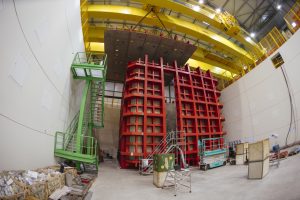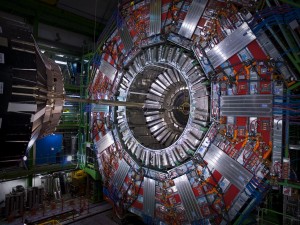The U.S. Department of Energy and CERN establish contributions for next-generation experiments and scientific infrastructure located both at CERN and in the United States

Prototype detectors for the Deep Underground Neutrino Experiment under construction at CERN. Photo: Maximilien Brice, CERN
The United States Department of Energy (DOE) and the European Organization for Nuclear Research (CERN) last week signed three new agreements securing a symbiotic partnership for scientific projects based both in the United States and Europe. These new agreements, which follow from protocols signed by both agencies in 2015, outline the contributions CERN will make to the neutrino program hosted by Fermilab in the United States and the U.S. Department of Energy’s contributions to the High-Luminosity Large Hadron Collider upgrade program at CERN.
Researchers, engineers and technicians at CERN are currently designing detector technology for the U.S. neutrino research program hosted by Fermilab. Neutrinos are nearly massless, neutral particles that interact so rarely with other matter that trillions of them pass through our bodies each second without leaving a trace. These tiny particles could be key to a deeper understanding of our universe, but their unique properties make them very difficult to study. Using intense particle beams and sophisticated detectors, Fermilab currently operates three neutrino experiments (NOvA, MicroBooNE and MINERvA) and has three more in development, including the Deep Underground Neutrino Experiment (DUNE) and two short-baseline experiments on the Fermilab site, one of which will make use of the Italian ICARUS detector, currently being prepared for transport from CERN.
The Long Baseline Neutrino Facility will provide the infrastructure needed to support DUNE both on the Fermilab site in Illinois and at the Sanford Underground Research Facility in South Dakota. Together, LBNF/DUNE represent the first international megascience project to be built at a DOE national laboratory.
The first agreement, signed last week, describes CERN’s provision of the first cryostat to house the massive DUNE detectors in South Dakota, which represent a major investment by CERN to the U.S.-hosted neutrino program. This critical piece of technology ensures that the particle detectors can operate below a temperature of minus 300 degrees Fahrenheit, allowing them to record the traces of neutrinos as they pass through.
The agreement also formalizes CERN’s support for construction and testing of prototype DUNE detectors. Researchers at CERN are currently working in partnership with Fermilab and other DUNE collaborating institutions to build prototypes for the huge subterranean detectors which will eventually sit a mile underground at the Sanford Underground Research Facility in South Dakota. These detectors will capture and measure neutrinos generated by Fermilab’s neutrino beam located 800 miles away. The prototypes developed at CERN will test and refine new methods for measuring neutrinos, and engineers will later integrate this new technology into the final detector designs for DUNE.
The agreement also lays out the framework and objectives for CERN’s participation in Fermilab’s Short Baseline Neutrino Program, which is assembling a suite of three detectors to search for a hypothesized new type of neutrino. CERN has been refurbishing the ICARUS detector that originally searched for neutrinos at INFN’s Gran Sasso Laboratory in Italy and will ship it to Fermilab later this spring.
More than 1,700 scientists and engineers from DOE national laboratories and U.S. universities work on the Large Hadron Collider (LHC) experiments hosted at CERN. The LHC is the world’s most powerful particle collider, used to discover the Higgs boson in 2012 and now opening new realms of scientific discovery with higher-energy and higher-intensity beams. U.S. scientists, students, engineers and technicians contributed critical accelerator and detectors components for the original construction of the LHC and subsequent upgrades, and U.S. researchers continue to play essential roles in the international community that maintains, operates and analyzes data from the LHC experiments.
The second agreement concerns the next phase of the LHC program, which includes an upgrade of the accelerator to increase the luminosity, a measurement of particle collisions per second. Scientists and engineers at U.S. national laboratories and universities are partnering with CERN to design powerful focusing magnets that employ state-of-the-art superconducting technology. The final magnets will be constructed by both American and European industries and then installed inside the LHC tunnel. The higher collision rate enabled by these magnets will help generate the huge amount of data scientists need in order to search and discover new particles and study extremely rare processes.
American experts funded by DOE will also contribute to detector upgrades that will enable the ATLAS and CMS experiments to withstand the deluge of particles emanating from the LHC’s high-luminosity collisions. This work is detailed in the third agreement. These upgrades will make the detectors more robust and provide a high-resolution and three-dimensional picture of what is happening when rare particles metamorphose and decay. Fermilab will be a hub of upgrade activity for both the LHC accelerator and the CMS experiment upgrades, serving as the host DOE laboratory for the High-Luminosity LHC Accelerator Upgrade and the CMS Detector Upgrade projects.




